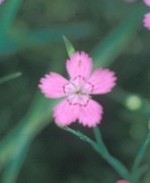 Maiden pink is an evergreen herbaceous perennial native to Europe and western Asia. It is a member of the carnation family, Caryophyllaceae.that also includes baby’s breath, Lynchnus, and soapwort (Saponaria). The plant forms loose mats with two kinds of stems, one prostate and four to six inches long, the other branched, eight to twelve inches long, and flower-bearing. The solitary flowers are ¾ ” wide, purple to rose colored, and are produced in profusion for eight to ten weeks during the summer. They are slightly fragrant and usually have a spotted band at the base of the sharply toothed petals. Shearing the plants after flowering may produce a second bloom. The narrow grass-like green leaves are ½ inch wide and four to six inches long and often have a rosy purple flush in cool weather. A good choice for a ground cover, front of the border, and rock garden. The generic name Dianthus comes from the Greek words Dios meaning of Zeus and anthos meaning flower. The specific epithet deltoids comes from the name of the Greek letter delta that resembles a triangle. Many good cultivars are available that vary primarily in height and color.
Maiden pink is an evergreen herbaceous perennial native to Europe and western Asia. It is a member of the carnation family, Caryophyllaceae.that also includes baby’s breath, Lynchnus, and soapwort (Saponaria). The plant forms loose mats with two kinds of stems, one prostate and four to six inches long, the other branched, eight to twelve inches long, and flower-bearing. The solitary flowers are ¾ ” wide, purple to rose colored, and are produced in profusion for eight to ten weeks during the summer. They are slightly fragrant and usually have a spotted band at the base of the sharply toothed petals. Shearing the plants after flowering may produce a second bloom. The narrow grass-like green leaves are ½ inch wide and four to six inches long and often have a rosy purple flush in cool weather. A good choice for a ground cover, front of the border, and rock garden. The generic name Dianthus comes from the Greek words Dios meaning of Zeus and anthos meaning flower. The specific epithet deltoids comes from the name of the Greek letter delta that resembles a triangle. Many good cultivars are available that vary primarily in height and color.
Type: Evergreen herbaceous perennial
Bloom: Solitary flowers ¾ ” wide, purple to rose colored for eight to ten weeks during the summer
Size: 6-12” H x 24” W
Light: Full sun, tolerates slight shade
Soil: Average, medium moist to dry, very well-drained
Hardiness: Zones 3-9
Care: Shear after flowring to maintain shape and attractive and promote rebloom; divide every two to three years to maintain vigor.
Pests and Diseases: Crown rot in poorly drained soil, leaf spot in humid climates
Propagation: Seed, stem cuttings n summer
Companion Plants: Lambs ear, artemesias, bellflowers (Campanula spp), thymes, sedums, dwarf yarrows
Outstanding Selections:
‘Albus’ (white flowers, 6” H)
‘Brillant’ (double crimson flowers, 6-8” H)
‘Samos’ crimson flowers, 9” H)
‘Zing Rose’ (deep-red flowers, 6-8” H)